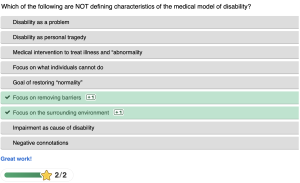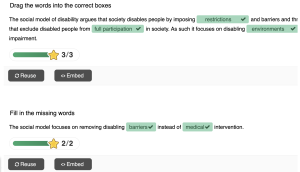5
Section one: The fundamentals
A)
Exercise 1: Notebook Prompt
Many of you are likely familiar with the concept of “ability inequity,” which the authors of this article define as “an unjust or unfair (a) ‘distribution of access to and protection from abilities generated through human interventions’ or (b) ‘judgment of abilities intrinsic to biological structures such as the human body’.”
However, they go on to identify the following “ability concepts” that are less familiar:
1) ability security (one is able to live a decent life with whatever set of abilities one has)
2) ability identity security (to be able to be at ease with ones abilities)
How prevalent are these forms of security among disabled people you know? Or, if you identify as a disabled person, would you say your social surroundings and community foster and support these kinds of security? Furthermore, while the focus of the article is on Kinesiology programs, it is also important to reflect on how academia in general accommodates for disability. If you feel comfortable answering this question, what has been your experience of postsecondary education to date?
-OR-
The authors also observe that “Ableism not only intersects with other forms of oppression, such as racism, sexism, ageism, and classism, but abilities are often used to justify such negative ‘isms’.”
What do you think this means? Provide an example.
| The statement “Ableism not only intersects with other forms of oppression, such as racism, sexism, ageism, and classism, but abilities are often used to justify such negative ‘isms'” indicates that people’s skills are often used to justify or explain discrimination. As an example, women have been thought of as “too emotional” or “too weak” to lead in the past, which is sexist and based on an opinion about their mental and physical strength. Also, people of colour have been wrongly represented as “less intelligent” or “less capable,” which is an example of both racism and ableism. Some people aren’t “able enough” to receive the same rights or chances., which is why these beliefs allow unfair treatment.
|
Exercise 2: Implicit Bias Test
Did anything surprise you about the results of the test? Please share if you’re comfortable OR comment on the usefulness of these kinds of tests more generally.
| I believe that these tests can be helpful since they show us ideas or assumptions we may not even be aware of. The results of the test didn’t really surprise me, but they did make me think more about how deeply ableism is ingrained in our processes and daily lives. The readings made me think about how ableism is more than just a physical hurdle. These tests can help you think about things, but you need to take action and change things at the system level.
|
B) Keywords
Exercise 3:
Add the keyword you contributed to padlet and briefly (50 words max) explain its importance to you.
|
The medical model of disability says that disability is a problem inside the person that is caused by a mental, physical, or cognitive defect. Focus is on identifying, treating, or “fixing” the person so they can act more like people who don’t have problems, according to this model. It believes that the inability is something that needs to be fixed or healed through therapy or medical care. If someone in a wheelchair can’t get into a building because it has stairs, the medical model would look for ways to help them walk again instead of asking why the building isn’t accessible. With this view, it is up to each person, not society, to get rid of hurdles and make settings where everyone feels welcome.
|
B) On Disability
Exercise 4: Complete the Activities


Exercise 5: Notebook Prompt
What do Fitzgerald and Long identify as barriers to inclusion and how might these apply to sport in particular?
Fitzgerald and Long talk about a few problems with including everyone that comes from the medical model of disability, mainly in sports. An important obstacle is the belief that disabled people can’t do sports or social activities because of their disabilities. Instead of including disabled people in regular events, this makes them feel left out or creates separate, often unfair opportunities for them. Some people think that sports should “fix” or “improve” disabled people, but instead, they should be able to enjoy sports for fun, competitively or even for socialization. This idea is called rehabilitative leisure. These ideas can make it harder for people with disabilities to get into sports and make them feel like patients instead of players, which reinforces stereotypes and limits real chances for inclusion.
C) Inclusion, Integration, Separation
Exercise 7: Notebook Prompt
Choose ONE of the three questions Fitzgerald and Long argue disability sport needs to address and record your thoughts in your Notebook.
- Should sport be grouped by ability or disability?
- Is sport for participation or competition?
- Should sport competitions be integrated?
3. Should sport competitions be integrated?
|
Part Two: Making Connections
A) Gender, Sport and Disability
Exercise 8: Complete the Activity
The paradox that sportswomen habitually face (as the authors observe, this isn’t confined to disabled sportswomen) involves the expectation they will be successful in a ‘masculine’ environment while complying with femininity norms in order to be recognized as a woman.
True or false?
Take a moment to reflect on this paradox below (optional).
| True |
B) Masculinity, Disability, and Murderball
Exercise 9: Notebook/Padlet Prompt
Watch the film, Murderball and respond to the question in the padlet below (you will have an opportunity to return to the film at the end of this module).
The authors of “Cripping Sport and Physical Activity: An Intersectional Approach to Gender and Disability” observe that the “gendered performance of the wheelchair rugby players can…be interpreted as a form of resistance to marginalized masculinity” (332) but also point out that it may reinforce “ableist norms of masculinity.” After viewing the film, which argument do you agree with?
a) Murderball celebrates a kind of resistance to marginalized masculinity
| Murderball does both of these things: it shows how the players fight back against the ideas that disabled people are passive or weak by giving them back their power, confidence, and pride in who they are as disabled guys. At the same time, the movie supports ableist and patriarchal norms by showing aggressiveness, competitiveness, and heteronormativity as signs of worth. This can make other forms of manly or disabled identities less important. |
Section Three: Taking a Shot
A) Resistance
B) Calling out Supercrip
Exercise 10: Mini Assignment (worth 5% in addition to the module grade)
1) Do you agree with the critique of the “supercrip” narrative in this video? Why or why not? Find an example of the “supercrip” Paralympian in the 2024 Paris Paralympics or Special Olympics coverage and explain how it works.
| I do agree with the critique of the ‘Supercrip’ narrative in the video. It is clear that the movie’s goal is to show how strong, talented and successful handicapped athletes are, but it falls into this problem that is problematic of showing disability through the lens of amazing inspiration. Athletes with disabilities do amazing things in the movie, which is set to the upbeat song “Yes I Can.” This may give some people hope, as well as it can also send an impression that they need to do incredible things to be perceived as important or inspiring. This ‘supercrip’ story puts too much pressure on disabled people to be special just to be recognized, which can be tiring and make them feel less human. Additionally, it perpetuates ableist thinking by implying that overcoming a handicap is what defines someone as heroic, rather than acknowledging that disabilities need to be welcomed and included despite their level of success.
Some of the news stories about Italian fencer Bebe Vio during the 2024 Paris Paralympics use the supercrip storyline as an example. Many articles and conversations about her success talk about how she “overcame” the fact that she lost her arms and legs to meningitis to become a winner. Even though she has done a lot, the fact that her disability is seen as something to overcome supports the idea that disabled people can only truly be successful when they beat the chance. It doesn’t talk about the system hurdle that disabled people face every day. Instead, it focuses on individual victories, which can take away from conversations about fairness, access and how important it is for all disabled people to be included in daily life. |
2) Does the film Murderball play into the supercrip narrative in your opinion? How does gender inform supercrip (read this blog for some ideas)?
(300 words for each response)
| I think that Murderball is a complicated and sometimes conflicting movie because it both supports and questions the supercrip story. On the one hand, the video praises the toughness, speed and determination of wheelchair rugby players, a majority of whom are disabled to begin with. It shows their lives as they really are, without any filters. They are strong rivals and emotionally complex men. This goes against the supercrip story by not sugarcoating the player’s experiences and representing them as real people, not just heroes.
But in some ways, Murderball also supports the idea that supercrips are bad people. People often say that the players got over their injuries through simple grit and physical aggression and that they regained their “masculinity” by doing well in a rough, competitive sport. The movie’s heavy focus on their sports prowess and stereotypically male behaviour, like drinking, swearing and making jokes about sex, could be seen as an attempt to show that they are “still men” even though they are handicapped. Masculinity and able-bodied standards imply that these individuals are inspiring not just since they are handicapped athletes, but because they fit within masculinity frameworks. Gender is a big part of how this supercrip story is told. Disabled women often have to deal with being desexualized or being invisible, but disabled men may feel like they need to act tough or dominant to regain their manhood. This pattern is strengthened by Murderball, which shows disability and manhood as things that need to be recovered instead of being changed. So, because it implies that value is found in overcoming handicap in ways that still conform to dominant gender standards, the film has the potential of reinforcing ableist and patriarchal views, even though it has some liberating elements. |

